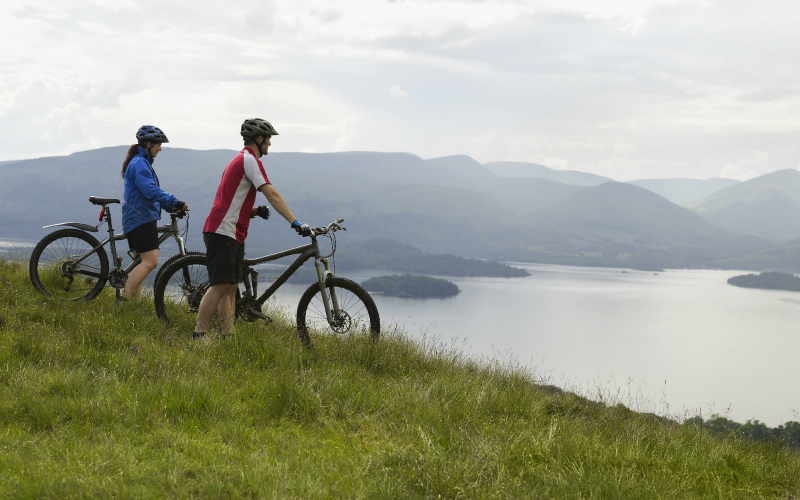
Mountain biking has gained traction in Scotland, with its popularity seemingly climbing steeply overnight. This has been noticed by the Scottish Government who earlier this year pledged additional funds to the Scottish Mountain Bike Strategy which aims to further increase numbers involved in mountain biking and the contribution of mountain biking to the economy. With this rise in popularity comes the risk of trails being constructed on privately owned land. How could these trails affect landowners and how should they be handled?
Wild Trails
Routes used for mountain biking which have been created on privately owned land without the permission or knowledge of the landowner are often known as ‘Wild trails’. If as a landowner you are faced with wild trails on your land, there are a number of elements which should be taken into account before taking action.
Public Access Rights
The subject of Public Access Rights and the ‘Right to Roam’ are discussed generally here. Whilst members of the public in Scotland have traditionally enjoyed access to hill ground, the rights were not formally recognised in law until the introduction of the Land Reform (Scotland) Act 2003. The Scottish Outdoor Access Code (“the Code”) later followed and outlines the rights, how they should be exercised and the rights and obligations of Landowners.
Generally speaking, access rights must be exercised in a lawful and reasonable manner. By definition this excludes any unlawful or criminal activity from the time at which it occurs, including causing any damage to your land for the creation of wild trails.
The Code contains specific advice in relation to cycling and mountain biking: mountain bikers should not endanger walkers and horse riders and they should give way to other users on narrow paths. They should avoid using wet, boggy or soft ground and churning up surfaces. The Code advises landowners they should work with local authorities or other organisations to try and identify routes across their land which are suitable for cycling.
Where wild trails are constructed, landowners cannot simply make their land inaccessible to cyclist and mountain bikers. Local Authorities have a number of powers ranging from removing any signs or obstructions preventing access, to acquiring land to facilitate the exercise of access rights.
Occupiers Liability
It is important to balance the public’s access rights with protecting Landowners interests. Anyone occupying land, whether as a tenant or landowner, has a duty of care towards people on the land, including those exercising their public access rights. Regulated by the Occupiers Liability (Scotland) Act 1960, an occupier or landowner is potentially liable for any injuries caused on their property which they knew or ought to have known about. In other words, once you have knowledge of any wild trails and the potential danger they pose, you could be open to liability.
To mitigate your potential liability as a landowner or occupier, you must be able to show you have taken reasonable steps to reduce the risk of harm to others. Where individuals construct wild trails and become injured using the trails, it is likely that they would be viewed as voluntarily accepting the risk of injury. The main concern from a liability viewpoint is the safety of others accessing the land.
Balancing the Interests
Taking these factors into account, it is a careful balancing act which is required when dealing with wild trails. There are a number of options available although these vary depending on whether or not the landowner chooses to accept mountain bikers on their land.
Dismantling the Trails
Although you cannot prevent mountain bikers from accessing your land, it is within your rights to dismantle any trails which have been constructed. This action will not be in breach of the Code provided it is done in a manner which does not prevent or deter access for other users. This can be an immediate way of dealing with the issue and may reduce the risk of other users becoming injured on your land. In dismantling the trails however, you could face criticism from the local mountain biking community. It may also encourage the construction of wild trails on other land previously free of trails.
Local Authorities
Although Local Authorities have a number of powers to deal with landowners who do not comply with the Code, they also have powers to deal with members of the public who exercise their rights of access in an unreasonable or unlawful manner.
A member of the relevant team within your Local Authority may be able to visit your land to view any trails which have been constructed. From there a view can be taken on what assistance can be provided. One option available to the Local Authority is to place warning signs on your land advising people of potential dangers. Where a sign is placed in this manner, it will likely contain the Local Authority’s details. This can be an additional support and remove some of the onus from the landowner.
Legal Alternatives
If the above options have been exhausted, there is the option to report the problem to the police. Since the building of wild trails on your land is in breach of the Code, the police can order anyone who enters your land for this purpose to leave. If the issue becomes unmanageable and you are able to locate the individuals constructing the trails, there is also the option to apply to Court for an Interdict. This option could be costly however and there is no guarantee of success. If you would like further information on the court process, please contact a member of our Dispute, Resolution and Claims team.
Accepting Mountain Bikers on your Land
The landowners position changes if they choose to accept mountain bikers onto their land. In actively allowing the trails, the duty of care under Occupiers Liability legislation will extend to include mountain bikers. To ensure you fulfil this duty, you may have to monitor the trails, inspect the trails to ensure they are in good condition and undertake maintenance of the trails where necessary. Landowners should also ensure they have public liability insurance in place if not done already.
If you choose to accept trails on your land, the first step may be to discuss this directly with those constructing the trails to agree a more appropriate route through your land. The agreed route should be one which does not inadvertently restrict the access rights of other users.
There are a number of other factors which should be taken into account in accepting mountain bikers on your land, for example, the environmental impact it may have on your land or the practical considerations such as nearby car parking. You may wish to seek further assistance from an appropriate organisation. Your Local Authority may be able to assist, although specialist organisations such Developing Mountain Biking in Scotland offer further guidance on building and managing trails.
For further information and advice on managing mountain bikers and wild trails on your land, please contact a member of our Land and Rural Business Team.
